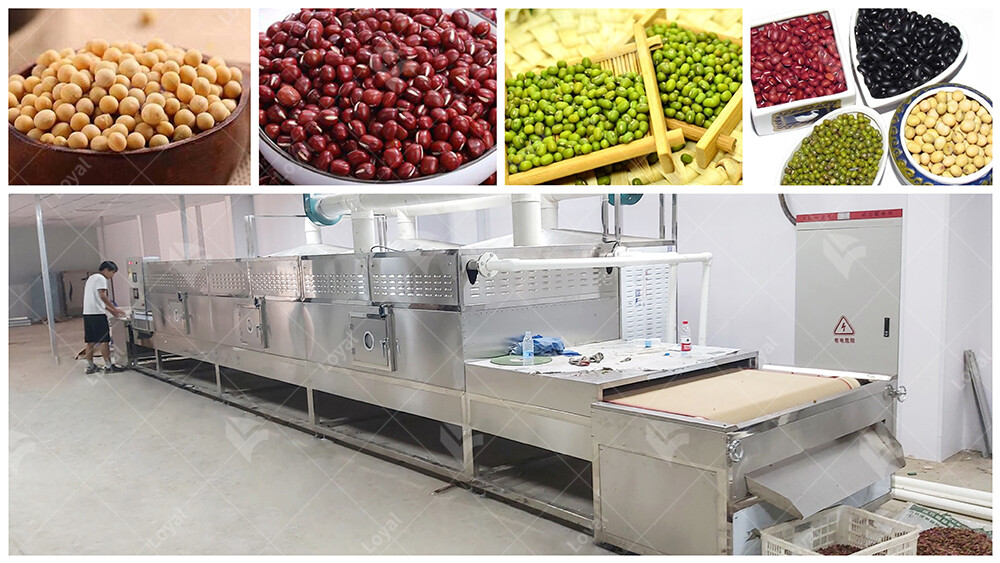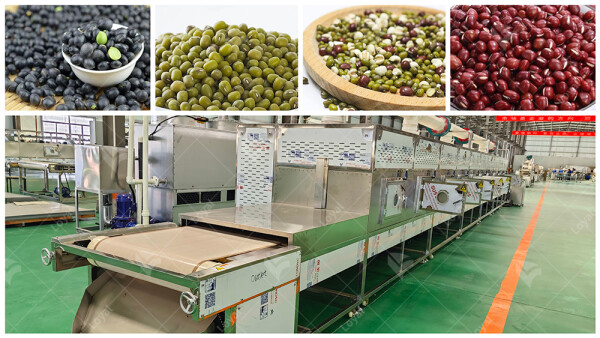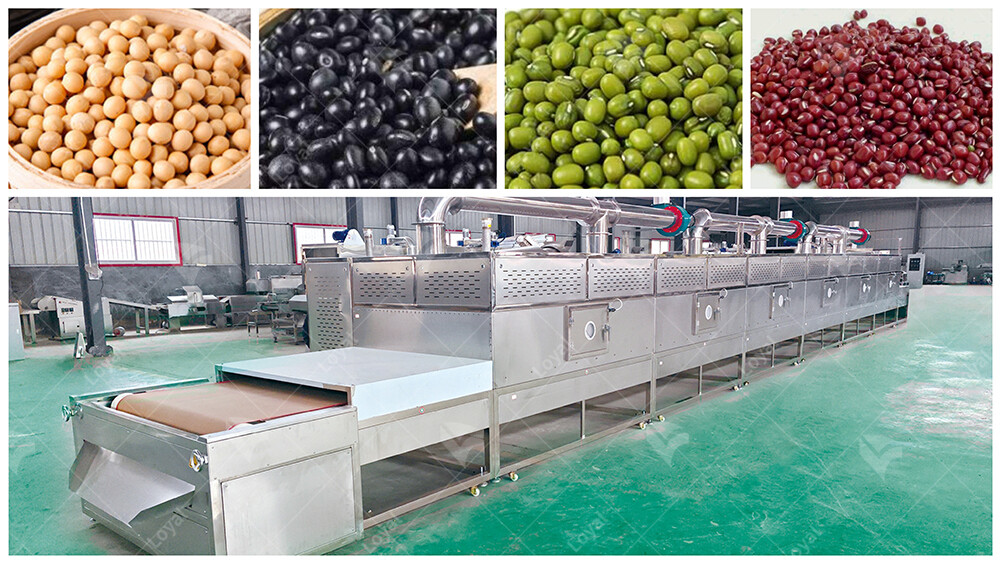The Ultimate Continuous Red Bean Mung Bean Microwave Drying Machine Guide to 2024
Introduction to Continuous Red Bean Mung Bean Microwave Drying Machines
Continuous red bean mung bean microwave drying machines represent a significant advancement in the food processing industry, specifically in the drying of red beans and mung beans. These machines utilize microwave technology to efficiently remove moisture from beans, resulting in faster drying times and superior product quality.
One of the key features of continuous microwave drying machines is their ability to provide a consistent and uniform drying process. Unlike traditional drying methods that may result in uneven drying and product degradation, microwave drying ensures that beans are dried evenly throughout, preserving their flavor, color, and nutritional content.
Additionally, continuous microwave drying machines offer increased throughput and productivity compared to batch drying methods. With the ability to continuously process large volumes of beans, manufacturers can achieve higher production rates while reducing energy consumption and labor costs.
Furthermore, these machines are equipped with advanced control systems that allow operators to adjust drying parameters such as temperature, humidity, and airflow to optimize drying efficiency and product quality. This level of precision control ensures that beans are dried to the desired moisture content without over-drying or under-drying.

Understanding the Principles of Microwave Drying Technology
Microwave drying technology operates on the principle of dielectric heating, wherein electromagnetic waves are used to generate heat within the product being dried. When exposed to microwave radiation, water molecules within the product absorb the energy, causing them to vibrate and generate heat, which in turn evaporates the moisture.
The key advantage of microwave drying technology lies in its ability to heat the product internally, rather than relying on external heat sources like convection or conduction. This results in faster and more uniform drying, as heat is generated directly within the product, leading to reduced drying times and improved product quality.
Moreover, microwave drying offers precise control over drying parameters, allowing operators to adjust factors such as power level, frequency, and exposure time to achieve the desired drying results. This level of control enables manufacturers to tailor the drying process to the specific requirements of different products, ensuring optimal drying efficiency and quality.
Additionally, microwave drying technology is highly energy-efficient, as it eliminates the need for preheating and reduces overall drying time. This not only saves energy but also reduces operating costs and environmental impact, making it a more sustainable option compared to traditional drying methods.

Key Components of Continuous Red Bean Mung Bean Microwave Drying Machines
Continuous red bean mung bean microwave drying machines are intricate systems comprising several essential components that work together to facilitate the drying process efficiently.
Firstly, the microwave generator is a fundamental component responsible for producing electromagnetic waves used for drying. These generators utilize high-power microwave sources to generate the necessary energy for the drying process. The frequency and power output of the microwave generator are carefully calibrated to ensure optimal drying conditions for red beans and mung beans.
Secondly, the conveyor belt system plays a crucial role in continuous drying operations. This component transports the beans through the drying chamber at a consistent speed, ensuring uniform exposure to microwave energy. The design of the conveyor belt is carefully engineered to withstand the rigors of continuous operation while maintaining precise control over bean movement.
Another essential component is the drying chamber, where the actual drying process takes place. This chamber is designed to contain the beans as they are subjected to microwave energy, allowing for efficient moisture removal. The chamber is typically constructed from materials that are resistant to microwave radiation and easy to clean to ensure food safety and hygiene.
Lastly, the control system is vital for monitoring and regulating various parameters throughout the drying process. This system includes sensors and controllers that monitor factors such as temperature, moisture content, and conveyor speed. By continuously adjusting these parameters, the control system ensures consistent drying results and prevents over-drying or under-drying of the beans.

Advantages of Using Microwave Drying Machines for Red Beans and Mung Beans
The utilization of microwave drying machines offers several significant advantages for drying red beans and mung beans compared to traditional drying methods.
Firstly, microwave drying is a rapid process that significantly reduces drying time compared to conventional methods. The high-frequency electromagnetic waves penetrate the beans quickly and uniformly, allowing for faster moisture removal. This results in higher throughput and increased productivity for food processing operations.
Secondly, microwave drying preserves the nutritional quality of red beans and mung beans more effectively than traditional drying methods. The rapid and uniform heating provided by microwave energy helps retain essential nutrients such as vitamins, minerals, and antioxidants, ensuring that the dried beans maintain their nutritional value.
Additionally, microwave drying offers better control over the drying process, allowing for precise adjustment of drying parameters such as temperature and moisture content. This level of control enables manufacturers to achieve consistent drying results and produce high-quality dried beans with minimal risk of over-drying or under-drying.
Furthermore, microwave drying machines are more energy-efficient than traditional drying methods, leading to lower energy consumption and operating costs. The ability to target specific moisture levels and eliminate the need for prolonged drying times further contributes to energy savings and sustainability.

Comparison with Traditional Drying Methods in the Food Industry
When comparing continuous red bean mung bean microwave drying machines with traditional drying methods in the food industry, several key differences and advantages become apparent.
Firstly, traditional drying methods often rely on heat sources such as convection ovens or sun drying, which can be time-consuming and less efficient compared to microwave drying. Continuous microwave drying machines utilize electromagnetic waves to generate heat directly within the food material, resulting in faster drying times and reduced energy consumption.
Secondly, traditional drying methods may lead to uneven drying and loss of nutritional value due to prolonged exposure to high temperatures. In contrast, microwave drying offers precise control over temperature and moisture levels, ensuring uniform drying and preserving the nutritional integrity of the red beans and mung beans.
Additionally, traditional drying methods may be limited by environmental factors such as weather conditions or space constraints. Continuous microwave drying machines can operate year-round and require minimal floor space, making them ideal for large-scale food production facilities with limited resources.
Moreover, traditional drying methods may pose safety risks associated with handling hot surfaces or combustion hazards. Continuous microwave drying machines offer a safer alternative with enclosed systems and automated controls that minimize the risk of accidents and ensure operator safety.

Factors to Consider When Selecting Continuous Microwave Drying Machines
When choosing continuous microwave drying machines for red beans and mung beans, several important factors should be taken into account to ensure optimal performance and efficiency.
Firstly, consider the capacity and throughput requirements of your production facility. Determine the volume of red beans and mung beans you need to process per hour or day to meet demand and select a drying machine with sufficient capacity to handle your workload.
Secondly, assess the energy efficiency and operating costs of different microwave drying machines. Look for models with energy-saving features such as variable power settings, insulation materials, and efficient heating elements to minimize utility expenses and maximize profitability.
Additionally, evaluate the design and construction of the drying machine to ensure durability and reliability in demanding industrial environments. Choose a reputable manufacturer with a proven track record of producing high-quality equipment and providing reliable customer support.
Furthermore, consider the versatility and flexibility of the drying machine in accommodating different types of food products and processing requirements. Look for adjustable settings, customizable programs, and optional accessories that allow for precise control and customization of the drying process.

Installation and Setup Guidelines for Efficient Operation
Installing and setting up a continuous red bean mung bean microwave drying machine requires careful planning and attention to detail to ensure efficient operation. Here are some guidelines to follow:
1. Location Selection: Choose a suitable location for installing the microwave drying machine. It should be a well-ventilated area with ample space for the equipment and easy access for maintenance.
2. Power Requirements: Ensure that the installation site has the necessary power supply to support the microwave drying machine. Verify the voltage and current requirements specified by the manufacturer and make any necessary arrangements with an electrician.
3. Equipment Positioning: Position the microwave drying machine in a level and stable manner to prevent vibrations and ensure proper operation. Follow the manufacturer's recommendations regarding clearance space around the equipment for ventilation and maintenance access.
4. Connection and Integration: Connect the microwave drying machine to any auxiliary equipment, such as conveyors or feed systems, following the manufacturer's instructions. Ensure proper alignment and integration to facilitate seamless operation.
5. Calibration and Testing: Before starting operation, calibrate the microwave drying machine according to the manufacturer's specifications. Conduct thorough testing to verify functionality and performance, making any necessary adjustments or fine-tuning as needed.
6. Operator Training: Provide comprehensive training to operators responsible for running the microwave drying machine. Ensure they understand proper operation procedures, safety protocols, and troubleshooting techniques to maximize efficiency and prevent accidents.
7. Documentation and Compliance: Maintain detailed records of the installation process, including equipment specifications, calibration reports, and training documentation. Ensure compliance with relevant regulatory standards and industry guidelines.

Maintenance and Troubleshooting Tips for Longevity
Proper maintenance and proactive troubleshooting are essential for ensuring the longevity and optimal performance of a continuous red bean mung bean microwave drying machine. Here are some tips to keep the equipment running smoothly:
1. Regular Cleaning: Establish a routine cleaning schedule to remove any debris, residue, or buildup from the microwave drying machine. Pay special attention to the interior chambers, conveyor belts, and ventilation systems to prevent contamination and maintain efficiency.
2. Component Inspection: Periodically inspect key components of the microwave drying machine, such as magnetrons, waveguides, and seals, for signs of wear or damage. Replace any worn or damaged parts promptly to prevent equipment malfunction and ensure consistent drying performance.
3. Lubrication and Lubricant Inspection: If applicable, lubricate moving parts of the microwave drying machine according to the manufacturer's recommendations. Regularly inspect lubricant levels and quality to ensure proper lubrication and prevent premature component failure.
4. Temperature and Power Monitoring: Monitor temperature and power levels during operation to detect any anomalies or deviations from normal operating parameters. Implement corrective actions as necessary to maintain optimal drying conditions and prevent overheating or underperformance.
5. Scheduled Maintenance Checks: Establish a schedule for scheduled maintenance checks, including comprehensive inspections, component replacements, and performance evaluations. Adhere to this schedule rigorously to identify and address any potential issues before they escalate.
6. Operator Training: Continuously train operators on proper maintenance procedures and troubleshooting techniques to empower them to address minor issues independently. Encourage a proactive approach to equipment maintenance and provide resources for ongoing learning and skill development.
7. Emergency Response Plan: Develop an emergency response plan outlining procedures for addressing unexpected equipment failures or malfunctions. Ensure all personnel are familiar with this plan and know how to respond quickly and effectively to minimize downtime and mitigate risks.

Future Trends and Innovations in Continuous Red Bean Mung Bean Microwave Drying Technology
The continuous advancement of technology in the food industry, particularly in the realm of drying equipment, has led to significant innovations in continuous red bean and mung bean microwave drying machines. Looking ahead to the future, several trends and advancements are anticipated to shape the landscape of this technology.
One prominent trend is the integration of smart technology and automation into continuous microwave drying machines. Manufacturers are increasingly incorporating sensors, IoT (Internet of Things) connectivity, and advanced control systems to enhance efficiency, optimize drying parameters, and ensure consistent product quality. These technological advancements enable real-time monitoring and adjustment of drying processes, resulting in higher productivity and reduced energy consumption.
Another emerging trend is the development of multifunctional continuous microwave drying machines capable of processing a variety of food products, including red beans, mung beans, and other grains or legumes. By offering versatility in application, these machines provide food producers with greater flexibility and cost-effectiveness, allowing them to adapt to changing market demands and diversify their product offerings.
Additionally, there is growing interest in sustainable drying technologies that minimize environmental impact while maximizing efficiency. Manufacturers are exploring innovative approaches such as hybrid drying systems, renewable energy sources, and waste heat recovery solutions to reduce carbon emissions and conserve resources. These sustainable practices not only benefit the environment but also contribute to the long-term viability and competitiveness of food production operations.
In conclusion, the future of continuous red bean and mung bean microwave drying technology is characterized by a convergence of smart automation, versatility, sustainability, and enhanced durability. By embracing these trends and innovations, food producers can optimize their drying processes, improve product quality, and stay ahead of the curve in an increasingly competitive market landscape.

References
The following are five authoritative foreign literature websites in the field of industrial microwaves:
1. IEEE Xplore Digital Library
Website: [https://ieeexplore.ieee.org/]
2.ScienceDirect
Website: [https://www.sciencedirect.com/]
3. SpringerLink
Website: [https://link.springer.com/]
4. Wiley Online Library
Website: [https://onlinelibrary.wiley.com/]
5. PubMed
Website: [https://pubmed.ncbi.nlm.nih.gov/]
 Telephone :+86-531-55583139
Telephone :+86-531-55583139 WhatsApp :+86 13256674591
WhatsApp :+86 13256674591 Email :
Email :










